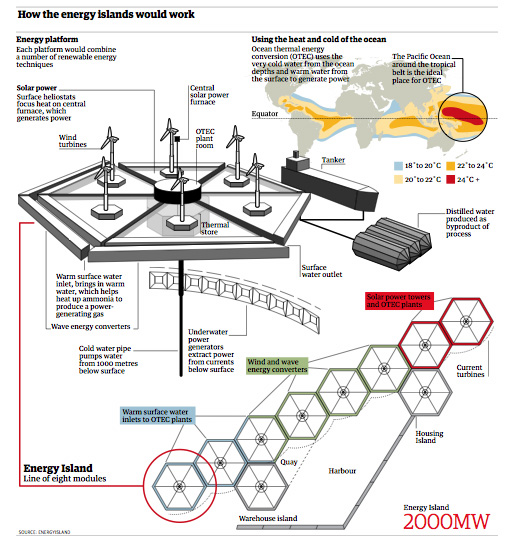From a distance it looks like an island paradise, but get closer and those tall structures that could be palm trees turn out to be wind turbines - and the surf laps against wave barrages instead of sandy beaches. Welcome to "Energy Island", a vision of how humans could help meet our future needs for energy, food and water using the power of nature in the tropics.
Alex Michaelis, the architect who gave David Cameron's west London home a green makeover - complete with miniature wind turbine, solar panels and water recycling system - will launch the concept this year with a bid for funding worth $25m (£12.6m) from Sir Richard Branson's Virgin Earth Prize.
His proposal, which is dramatically more ambitious than the work he did on the Conservative leader's semi-detached house, is to build archipelagos of artificial islands that will produce electricity, clean water and even food in the belt of warm water that passes from the Caribbean across to the south China Sea, the Indian Ocean and west Africa.
Each island would be built on a floating platform and at its centre would be a plant that converts heat from the tropical sea into electricity and drinking water. Below deck would be marine turbines to harness energy from underwater currents and around the edge floating devices to provide wave power.
Vegetable farms and homes for workers will complete the colony and the power will be piped back to be used on the nearest populated land mass.
Michaelis, who is working together with his father Dominic, an engineer, estimates that each island complex could produce 250MW. It would take more than 50,000 installations to satisfy current world demand for energy, but Michaelis senior believes it is not impossible. "If we consider that we are at war to find a new form of clean energy, wartime effort in world war two produced vast numbers of planes, tanks, ships and other armaments on both warring sides," he said. "20,300 Spitfires alone were built, making the construction of more than 50,000 of these plants seem a reasonable number."
Branson is searching for an innovative idea that can cause a dramatic reverse in global warming and has given the world's inventors until February 2010 to submit ideas. The Michaelis team is searching for funding to test the principles of its invention with a prototype, but believe that it could be the breakthrough that the billionaire and his panel of judges, including Al Gore and climate scientist James Lovelock, are looking for. "For centuries we have been trying to master nature, but now our last hope is to work with nature," said Dominic Michaelis.
At the heart of each island is an ocean thermal energy conversion plant which can create electricity from sea water where the difference between the temperature of the surface water and the deep is 20C or more. The warm sea water is pressurised to transform it into vapour which drives a turbine. The vapour is condensed against a surface cooled by water from the deep, to produce desalinated water. The energy from this technology, which was originally invented in 1881 by a French engineer, would be supplemented by wind turbines and a "power tower" which captures energy from the sun by using mirrors to focus solar rays on a central "furnace".
"Each energy island would operate in a similar way to an oil rig, with about 25 people living there to operate the energy systems and food farms," said Alex Michaelis. "Teams of workers would spend six weeks on the island and six weeks off. The islands can be linked together so if you wanted a bigger power output you could simply build a bigger settlement. In the future these energy islands could be linked together to become eco-tourism attractions."
According to the designs, the "energy islanders" could farm sea food in pens beneath the deck and vegetables could be grown in shaded patches on the platform using some of the cold, desalinated water produced by the plant. The islands are also designed to act as ports for supertankers to transport the 300,000 litres of desalinated water which will be produced each day. Sir Terry Farrell, the architect, has proposed that similar artificial islands should be built in the Thames estuary to provide a new port for London.
The Michaelis team intends to pilot the energy island in waters off the British Virgin Islands or in the Indian Ocean in the coming year.


